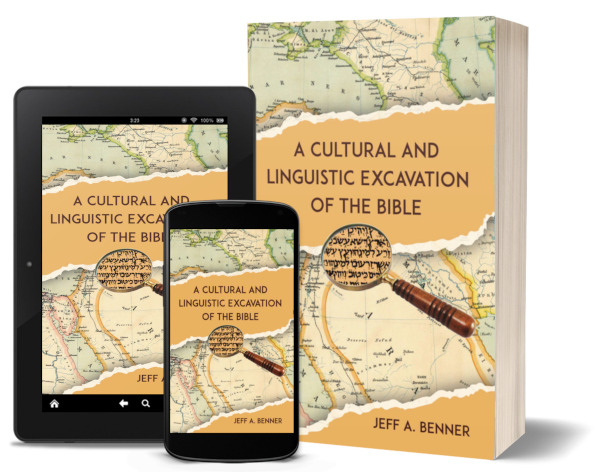A Cultural and Linguistic Excavation of the Bible

The Bible is an Ancient Near Eastern text, which was written millennia ago within a time and culture that is vastly different from our own. The authors of the Bible had a perspective on life and the world around them that was steeped with their own traditions, customs and thoughts. When reading and studying this text we cannot interject our own cultural perspectives into the text, to do so would bring about interpretations and conclusions that are far removed from its intended meaning. But if we read the Bible from the perspective of those who wrote it and study their language, philosophy and culture from within its original context, the Bible will spring to life in ways you never thought possible. (306 pages)
“Bringing Ancient Hebraic understanding of scripture to modern day enthusiasts.”
-- David Johnstone
“Excellent study material.”
-- Jim Gramm



Preface
That which was from the beginning, which we have heard, which we have seen with our eyes, which we looked upon and have touched with our hands, concerning the word of life. (1 John 1:1, ESV)
Instead of reading the Bible with just our minds, we need to read it with our senses, as well. That is, we need to see, hear, smell, taste and touch it from the perspective of those who lived it. In other words, do not experience the idea of “grace” as an abstract thought in the sense of being favored. Instead, know it through the more concrete experience of Hebrew thought, which is like the experience of coming home after being away for a long period of time.
For me, this journey began in 1992. For the first time in my life, I had recently begun a very serious study of the Bible, inspired in part because my new wife’s church had some beliefs that were very different from my own. I can still remember sitting at the kitchen table with my Bible, a Bible concordance and dictionary and my notepad, doing a study on angels.
Using the Bible concordance, I discovered that the “messengers” Jacob sent to his brother in Genesis 32:3 was in-fact, the same “angels” he met with in Genesis 32:1. The concordance revealed that the Hebrew word behind “messenger” was the very same Hebrew word behind the word “angel”—mal’akh. This raised a few questions in my mind:
“Why would the translator use two different words for this one Hebrew word?”
“Is the translator changing the original meaning of the passage?”
“Where else has the translator been so inconsistent with his translations?”
Unbeknownst to me at the time, this and other similar discoveries in my biblical studies laid the foundation for my Ancient Hebrew Lexicon of the Bible, published in 2005. I wrote it to bring to light the cultural and linguistic background of the words that form the Hebrew Bible.
The insights into the culture and language of the Bible that I learned while writing the lexicon spurred me on to doing my own translation, the culmination of which was The Torah: A Mechanical Translation[1], published in 2019. Also in 2019 I published my Benner’s Commentary on the Torah.
Now, I invite you to continue this journey with me as we walk through A Cultural and Linguistic Excavation of the Bible, where we will dig deep into the history of the Bible, its people and their language, and uncover hidden truths that have been lost through centuries of mistranslations, misinterpretations and textual manipulation.
Jeff A. Benner
Magnolia, MS. USA
June 28, 2023



Introduction
We all are aware that behind the English translation of our Bibles are Hebrew, Aramaic and Greek words. But what many may not have considered is that behind those ancient words were cultures and philosophies vastly different from our own. The Biblical authors’ perspectives on life and the world around them were steeped in their traditions, lifestyles, manners and thoughts. When reading and studying this ancient text, we cannot interject our cultural perspectives into the narrative without bringing about interpretations and conclusions far removed from the authors’ intended meaning.
To illustrate the importance of this, let’s examine a passage from the New Testament and interpret it from within its original cultural and linguistic contexts.
“Just then a woman who had been subject to bleeding for twelve years came up behind him and touched the edge of his cloak. She said to herself, ‘If I only touch his cloak, I will be healed.’ Jesus turned and saw her. ‘Take heart, daughter,’ he said, ‘your faith has healed you.’ And the woman was healed at that moment.” (Matthew 9:20-22, NIV)
Have you read a passage and found yourself asking questions that nobody else is asking? “Why is the text so specific that she needed to touch the edge of his garment?” Or, “How did she know that she would be healed if she touched this edge?” Questions like this deserve answers and oftentimes, these answers can only be found in the culture and/or language behind the translations.
Let’s begin with the “cloak” or, as some translations say, “garment.” This would be the rectangular, poncho-like garment worn by all Jewish men. More on this a little later. Behind the English word “edge” is the Greek word κρασπεδον (kraspedon, Strong’s[2] #G2899), which means “edge“ or “border.”
However, when we examine how this Greek word was used in the Septuagint, a Greek translation of the Old Testament and contemporary to the New Testament period, we find that it was used to translate the Hebrew word ציצית (tsiytsiyt, Strong’s #H6734), which is usually translated as “fringe,” such as can be seen in the following passage:
“[S]peak[3] to the sons of Yisra’eyl[4], and you will say to them, and they will make for themselves fringes (tsiytsiyt in Hebrew and kraspedon in Greek) upon the wings of their garments…” (Numbers 15:38, RMT)
The Hebrew word for “wing” is כנף (K.N.Ph, Strong’s #H3671) and does mean “wing,” such as the “wing” of a bird, but it can also mean “corner;“ which in the context of this passage refers to the four corners of Hebrew males’ garments. In the image below (Figure 4), we see an example of the tsiytsiyt or “fringe” tied to the “corner” of the garment.

Figure 4. A tsiytsiyt
(Image is in the Public Domain)
We now know that the woman in the passage from Matthew was reaching for the “corner” of his garment where the tsiytsiyt would have been tied, but we still do not know why she reached for the corner. To answer this question, we turn to the Book of Malachi:
“But unto you that fear my name shall the Sun of righteousness arise with healing in his wings…” (Malachi 4:2, KJV)
And now we are back to the word “wings,” the Hebrew word being kanaph. As this word also means “corners,” we now know the why; he, Yeshua, had healing in the “corners” of his garment. But why would Yeshua be referred to as the “sun of righteousness?” When we do a little investigation into this word, we find our answer. The Hebrew word for “sun” is שמש (shemesh, Strong’s #H8121). However, while not used in the Bible, this Hebrew word can mean “minister[5].” Now let’s take another look at Malachi 4:2, but this time with new understanding:
“But unto you that fear my name shall the minister of righteousness arise with healing in his corners…”
Before moving on, we need to take a closer look at the Hebrew word tsiytsiyt. As we have seen previously, this word is used for the “fringes” on the corners of the garments, but that is not what this word means literally. It specifically means “blossom[6].” In the same way that the function of the blossom is to produce fruit, the function of the tsiytsiyt is to remind the wearer that he is to produce fruit, just as is stated in the verse that follows the command to wear the tsiytsiyt:
“And it shall be unto you for a fringe, that ye may look upon it, and remember all the commandments of the LORD, and do them…” (Numbers 15:39, KJV)
In the above word study, we have experienced the importance of understanding the Bible from its original cultural and linguistic perspectives. In the pages that follow, we will continue to excavate the Bible, uncovering its many riches by digging into the meanings behind the words and phrases. Gear up and let’s get started!



Footnotes:
1. Accompanying this translation is the Revised Mechanical Translation (RMT), which is occasionally referenced in this work.
2. James Strong’s The Exhaustive Concordance of the Bible, besides being a concordance, includes a dictionary of every Hebrew and Greek word in the King James Version of the Bible and was first published in 1890. As part of this concordance and dictionary, Strong assigned a number to each Hebrew (identified with “H” before the number) and Greek (identified with “G” before the number) word of the Bible.
3. One of the attributes of the RMT is that it does not use punctuation or upper-case letters in its translation because these conventions did not exist in the Hebrew text. This translation attempts to mimic the Hebrew in every way possible. The only exceptions are the use of commas to identify different clauses that are evident in the Hebrew, and identification of names by using upper case for the first letter.
4. In the RMT, names are transliterated from the Hebrew text (i.e. Yisra’eyl). Other translations take their transliteration of names from the Greek Septuagint (i.e. Israel).
5. In the Bible we do find the Aramaic verb שמש (shemash, Strong’s #H8120) which means “to minister.” As Hebrew and Aramaic are sister languages, many of the words in their vocabularies are interchangeable.
6. The word tsiytsiyt is derived from the word ציץ (tsiyts, Strong’s #H6731), a literal blossom, and its cognate, tsiytsiyt, is a figurative blossom.
© Jeff A. Benner


